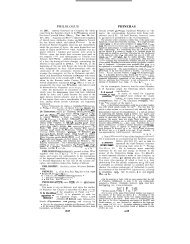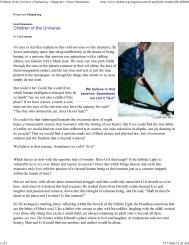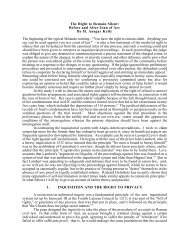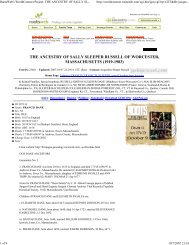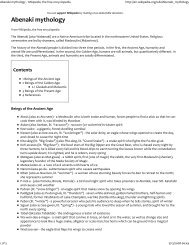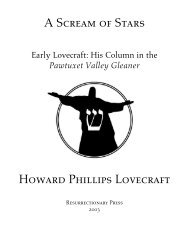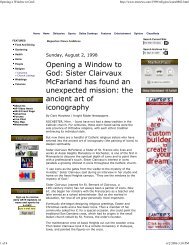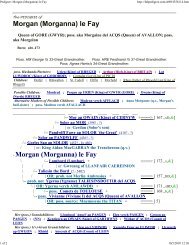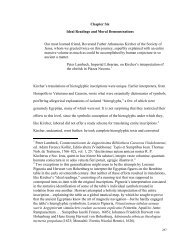Encylodaedia Biblica; a critical dictionary of the literary, political and ...
Encylodaedia Biblica; a critical dictionary of the literary, political and ...
Encylodaedia Biblica; a critical dictionary of the literary, political and ...
Create successful ePaper yourself
Turn your PDF publications into a flip-book with our unique Google optimized e-Paper software.
<strong>and</strong> possibly<strong>the</strong> third wiil represent Jerahmeel, <strong>the</strong>fifrh(Tirzah)<br />
will come from Zarephath <strong>the</strong> second (Noah) from some form <strong>of</strong><br />
Manahnth (b. Shobal), ;aLd Zelophehad will presumably he a<br />
compound <strong>of</strong> two ethnic or tribal names, <strong>and</strong> since <strong>the</strong>se names<br />
have to be Negeh names, <strong>the</strong> most probable explanation <strong>of</strong> <strong>the</strong><br />
name is Ishmael-hadad (cp 15s with 1 5 [SHELEPH], ~ <strong>and</strong> 7551<br />
[ZILPAH], which almost certainly come from ixynw). Hadad<br />
appears in Gen. 25 I j a:. <strong>the</strong> eighth son <strong>of</strong> Ishmael. Hepher<br />
<strong>and</strong> Gilead, with which Zelophehnd is also genealogically<br />
connected are Negeb names.1<br />
The nlianing <strong>of</strong> <strong>the</strong> statement that Zelophehad had five<br />
daughters <strong>of</strong> course is that <strong>the</strong>re were five minor clans de-<br />
pendent oh <strong>the</strong> great central clan called Zalp-had, or Ishmael-<br />
hadad. T. K. C.<br />
(9.v. 1.<br />
ZEL~T~s<br />
(ZHhWTHC), L~, 615 AV, RV<br />
ZELZAH (&y), I S, lo 2. See<br />
SEPULCHRE.<br />
ZEWAIM (2*,3?! ; see Kittel, SBOT, Heb., on<br />
Ch.134v <strong>and</strong> On lermination see 5 1°7)’<br />
. _. .<br />
[AI, aal*aperl* [LI).<br />
2. ’The name <strong>of</strong> a mountain ‘in <strong>the</strong> hill-country <strong>of</strong><br />
Ephraim,’ from <strong>the</strong> top <strong>of</strong> which ABIJAH delivered an<br />
address to Jerobonm <strong>and</strong> <strong>the</strong> Israelitish army (z Ch.<br />
134 ; uo,uopwv [BAL], uapapwv [Niese], or utpapwv<br />
[Naber], Jos. Ant. viii. 11 z = 274). See Ber<strong>the</strong>au.<br />
Both I <strong>and</strong> z suggest most interesting problems.<br />
Conder (PEP, 187:7. p. 26), following Van de Velde<br />
<strong>and</strong> Robinson, identifies I. with <strong>the</strong> ruin es-Samra,<br />
2-3 m. W. from <strong>the</strong> Jordan <strong>and</strong> 15-16 m. in a direct line<br />
E. from Be<strong>the</strong>l, <strong>and</strong> points out that <strong>the</strong>re are two ruins<br />
close toge<strong>the</strong>r bearing <strong>the</strong> same name (Samra). Buhl<br />
(PnL 180) inclines to accept this combination. Those,<br />
however, who take this line mnst, at any rate, separate<br />
<strong>the</strong> city from <strong>the</strong> mountain called Zemaraim, for a<br />
situation overlooking <strong>the</strong> Jordan valley will hardly suit<br />
<strong>the</strong> Chronicler’s narrative ; v. 19 suggests that <strong>the</strong> spot<br />
was not far from Be<strong>the</strong>l. The matter needs reconsideration.<br />
We have now to indicate <strong>the</strong> new position <strong>of</strong> <strong>the</strong> questions<br />
resulting from our criticism <strong>of</strong> <strong>the</strong> text, <strong>and</strong> first <strong>of</strong> that relating<br />
to 2. We have seen (JEIIOBOAM, T ; REHOBOAM ; SHECHEM ;<br />
SHILOH) that <strong>the</strong> scene <strong>of</strong> <strong>the</strong> narratives respecting Jeroboam<br />
<strong>and</strong> Rehoboam (<strong>and</strong> <strong>of</strong> course Abijah) was placed by <strong>the</strong> original<br />
writers in <strong>the</strong> Negeb, <strong>the</strong> possession <strong>of</strong> which was coveted both<br />
by Jeroboam <strong>and</strong> by Rehoboam, as well as by <strong>the</strong> Jerahmeelites,<br />
because it was <strong>the</strong> ‘ HoTy L<strong>and</strong>’ <strong>of</strong> Israel <strong>and</strong> <strong>of</strong> Jerahmeel,<br />
containing <strong>the</strong> most ancient sacred spots <strong>of</strong> both sections 0;<br />
Israel <strong>and</strong> <strong>of</strong> <strong>the</strong> closely related people <strong>of</strong> Jerahmeel. ‘ Epbraim<br />
is as much a son<strong>the</strong>rn as a nor<strong>the</strong>rn name, <strong>and</strong>, whatever be its<br />
origin (cp REPHAIM), is a syiionym <strong>of</strong> ‘ Jerahmeel.’ At <strong>the</strong><br />
resent time, Be<strong>the</strong>l (perhaps=Dan-i.e., Hain$ah, see Luz ;<br />
F ROPHET, 8 IO; SHECHEM), Jeshanah (perhaps misread for<br />
Dljd, <strong>the</strong> sou<strong>the</strong>rn Shunem, cp SHEN, SHUNEM), <strong>and</strong> Ephron<br />
(probably near <strong>the</strong> place miscalled Shechem, but really named<br />
Cu5ham-jerahmeel, see SHECHEM, z ; MACHPELAH), were in <strong>the</strong><br />
h<strong>and</strong>s <strong>of</strong> Jeroboam. According to <strong>the</strong> Chronicler (2 Ch. 13 IS),<br />
Rehoboam took <strong>the</strong>se cities from Jeroboam.<br />
Turning now to I, we! have seen that P, as a geographer,<br />
<strong>of</strong>ten works on lists which properly belong to an ancient<br />
geographical survey <strong>of</strong> <strong>the</strong> Negeb. This is <strong>the</strong> case, not only<br />
with <strong>the</strong> name-lists <strong>of</strong> Judah, Issachar, Asher, <strong>and</strong> Naphtali.<br />
but also with that <strong>of</strong> Benjamin (cp ZELA). The names Jericho,<br />
Beth-hoglah, <strong>and</strong> Emek-keziz in Josh. 18 21 probably come from<br />
Jerahmeel, Beth-meholah (=Beth-jerahmeel), <strong>and</strong> Maacath-<br />
cush, places in <strong>the</strong> Negeb ; whilst <strong>the</strong> Beth-arabah <strong>and</strong> Zemaraim<br />
in u. 22 probably come from Beth-‘arab <strong>and</strong> Simrim or Simr2.m.<br />
To say where <strong>the</strong>se places stood, except that one <strong>of</strong> <strong>the</strong>m is<br />
presumably REHOBOTH (q.v.), is beyond our power. It is<br />
possible (though Gen. 10 18 confirms sm) that har->imrim is <strong>the</strong><br />
same as har-Eimron in Am. 3 g(?) 4 I 6 T .(see PROPHET, I 35 ;<br />
SHINIRON). Perhaps Simron was in <strong>the</strong> h<strong>and</strong>s <strong>of</strong> Abijah<br />
(according to <strong>the</strong> Chronicler’s authority) <strong>and</strong> Jeroboam had<br />
come with <strong>the</strong> object <strong>of</strong> besieging it. Thdre is, at any rate, no<br />
reason whv I. <strong>and</strong> 2. should not be identified. CD ZEMARITE.<br />
T. K. C.<br />
ZEMARITE (’?Q!l), Gen. 1018 I Ch. 116. See<br />
GEOGRAPHY, 8 16, 4.<br />
1 For <strong>the</strong> sou<strong>the</strong>rn Gilead cp RAMOTH-GILEAD, <strong>and</strong> Cn’f.<br />
Bi6. on Jer. 8 22.<br />
cap. [A], capapra [Ll), b. Becher in a genealogy <strong>of</strong> BENJAMIN<br />
(q.v., 8 9, ii. a), I Ch. 7 8, cp Zlhtxl (S 36).<br />
ENAN (Ip), place (as <strong>the</strong> text st<strong>and</strong>s) in <strong>the</strong><br />
SHEPHELAH, mentioned with Hadashah <strong>and</strong> Migdalgad<br />
(CENNA [B], -M [A], CENAM [L]). Josh. 1537T;<br />
presumably identical with <strong>the</strong> ZAANAN (la?’%) <strong>of</strong> Mic.<br />
111 (CAiNhN [Aid. <strong>and</strong> Some MSS], CENNAN [some<br />
MSS, Syro-Hex.], CISNNAAP [Ba,bAQ*],-~~~ [Val).<br />
The probability is, however, that <strong>the</strong>re is a mistake, <strong>and</strong> that<br />
nei<strong>the</strong>r <strong>the</strong> Zenan <strong>of</strong> Joshua nor <strong>the</strong> Zaanan <strong>of</strong> Micah was in<br />
1 <strong>the</strong> ShZphSlah. As in <strong>the</strong> case <strong>of</strong> o<strong>the</strong>r lists <strong>of</strong> tribal placenames,<br />
P seems to have been indebted in Josh. 15 338 to lists<br />
<strong>of</strong> place-names belonging to different parts <strong>of</strong> <strong>the</strong> Negeb (see<br />
’<br />
WARS OF THE LORD<br />
[BOOK OF]). Among <strong>the</strong> names which,<br />
<strong>critical</strong>ly considered, are specially favourable to this view, are<br />
Eshtaol, Zorah, En-gannim, Tappuah, Jarmuth, Adullam,<br />
bocob, Mizpeh, Jok<strong>the</strong>el, Lachish, <strong>and</strong> we may now add Zenan,<br />
Hadashah, <strong>and</strong> Migdal-gad, which are grouped toge<strong>the</strong>r in<br />
7,. 37. That Zenan may be presumed to be identical with <strong>the</strong><br />
Zaanan <strong>of</strong> Micah, is obvious. Now, if Mic. 1 he criticised in<br />
combination with o<strong>the</strong>r prophecies relative to an invasion <strong>of</strong><br />
Judah, it will appear that <strong>the</strong> invaders are more probably<br />
..<br />
those which suffer from <strong>the</strong> invasion is, not PlDW (Samaria),<br />
but Pl?? (SHIMRON) in <strong>the</strong> Negeb. See PROPHET, $ 38.<br />
ijxs will <strong>the</strong>refore presumably he=jyr (Zoan), <strong>and</strong> is (Zin),<br />
both <strong>of</strong> which forms appear to have been connected geo-<br />
graphically with <strong>the</strong> famous Kadesh (cp PARADISE, $3 6;<br />
SODOM). The original form, <strong>the</strong>refore, <strong>of</strong> <strong>the</strong> names in Josh.<br />
15 37 was not improbably ‘Zoan, Kadesh, Jerahmeel-gad [or<br />
simply Jerahmeel1,’<strong>and</strong> in Mic. 111, besides Shaphir (Sbamir?),<br />
<strong>and</strong> Beth-ezel-<strong>the</strong> latter <strong>of</strong> which is clearly a Negeb name-we<br />
may recognise Jerahmeel (I& nw>-n*,y= $~oni. nw*) <strong>and</strong><br />
Zoan. It IS probable, however, that Zoan or Zaanan (Zenan),<br />
like ZIN (q.n.), comes from <strong>the</strong> widely-spread race-name Ishmael<br />
through <strong>the</strong> intermediate form Zibeon (iiyir). See ZIBEON,<br />
<strong>and</strong> cp Crif. Bi6. T. K. C.<br />
ZENAS (ZH NAC [Ti. WH], abbrev. from Zenodorus ;<br />
cp ARTEMAS, OLYMPAS, <strong>and</strong> NAMES. 5.86. end), a<br />
lawyer (YO~IKOS), is thus alluded to in Tit. 313 : ‘ Be<br />
zealous in helping Zenas <strong>the</strong> lawyer <strong>and</strong> Apollos on<br />
<strong>the</strong>ir way, that <strong>the</strong>y want for nothing.’ Whe<strong>the</strong>r he<br />
was a Jewish lawyer or a Roman jurisconsult is uncertain;<br />
but <strong>the</strong> non-Hebrew name <strong>and</strong> <strong>the</strong> short<br />
criticism <strong>of</strong> VOW~KO~ in Tit. 39 (cp Zahn, EinZ. 1435)<br />
make for <strong>the</strong> latter, <strong>and</strong> <strong>the</strong> association with Apollos<br />
suggests that he was possibly <strong>of</strong> Alex<strong>and</strong>rian origin.<br />
In <strong>the</strong> lists <strong>of</strong> <strong>the</strong> ‘seventy’ compiled by <strong>the</strong> Pseudo-Doro<strong>the</strong>us<br />
<strong>and</strong> Pseudo-Hippolytus he is made bkhop <strong>of</strong> Diospolis, <strong>and</strong><br />
he is mentioned in Menrea <strong>of</strong> <strong>the</strong> Greek church as author <strong>of</strong><br />
<strong>the</strong> (no longer extant) Acts <strong>of</strong> Tzlus.<br />
ZEPHANIAH (??DY, ‘whom Yahwb hides,’ or<br />
a defends,’ § 30, to which add <strong>the</strong> references CIS i. 1207,<br />
etc. ; Lidzbarski, H<strong>and</strong>& 359[cp also below,<br />
1. Name<br />
<strong>and</strong> date. 2~41; CO@ONlAC). I. Son Of Cushi, <strong>the</strong><br />
ninth, according to <strong>the</strong> order <strong>of</strong> his book,<br />
among <strong>the</strong> twelve minor prophets, flourished in <strong>the</strong> reign<br />
<strong>of</strong> Josiah <strong>of</strong> Judah, <strong>and</strong> apparently before <strong>the</strong> great<br />
reformation in <strong>the</strong> eighteenth year <strong>of</strong> that king (621<br />
B. c. ). For various forms <strong>of</strong> idolatry pnt down in that<br />
year (z K. 234J m) are spoken <strong>of</strong> by Zephaniah as still<br />
prevalent in Judah (1 4J ), <strong>and</strong> are specified in such a<br />
connection as to imply that <strong>the</strong>y were not <strong>the</strong> secret sins<br />
<strong>of</strong> individuals, but held <strong>the</strong> first place among <strong>the</strong> national<br />
backslidings that could, as <strong>the</strong> prophet teaches, be re-<br />
moved only by a sweeping judgment on <strong>the</strong> state. Of<br />
<strong>the</strong> person <strong>of</strong> Zephaniah nothing is known ; but inas-<br />
much as his genealogy, contrary to <strong>the</strong> usual practice in<br />
<strong>the</strong> case <strong>of</strong> <strong>the</strong> prophets (see Is. 1 I Jer. 1 I Ezek. 13 Hos.<br />
1 I Joel 1 I) is carried back four generations, it has been<br />
conjectured that his great-great-gr<strong>and</strong>fa<strong>the</strong>r Hezekiah<br />
(11) is <strong>the</strong> king <strong>of</strong> that name, <strong>and</strong> if so he will have<br />
belonged to <strong>the</strong> highest class <strong>of</strong> Jud;ean society.<br />
The genuineness <strong>and</strong> integrity <strong>of</strong> <strong>the</strong> short prophecy<br />
ascribed to Zephaniah do not seem to be open to reason-<br />
2. able doubt. Stade (GZ1644) sus-<br />
<strong>and</strong> integrity. pects (on account <strong>of</strong> <strong>the</strong> ideas<br />
expressed in <strong>the</strong>m) 21-3 II <strong>and</strong> 3 ;<br />
<strong>and</strong> it is true, if 3 were a distinct oracie, <strong>the</strong>re would be<br />
5401 5402



